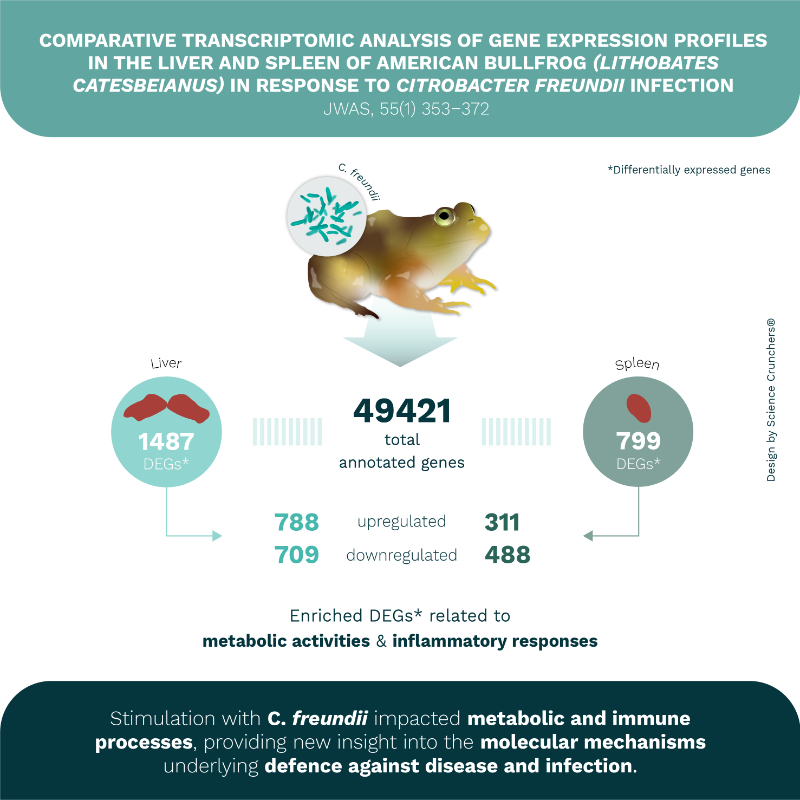JWAS Editor's Choice Awards 56(1)
The use of integrated multi-trophic aquaculture (IMTA) for multi-species culture is not new, but thi...

The American bullfrog (Lithobates catesbeianus) has a high market value for human consumption and this amphibian species is now commercially cultured in many parts of the world. In China, amphibian aquaculture of the American bullfrog reached 500,000 tons in 2019. As with many cultured species, stress events associated with high-density culture increase the bullfrog’s susceptibility to aquatic pathogens, which can result in disease outbreaks. Several bacterial pathogens can cause a condition known as red-leg syndrome (RLS), and one of these pathogens (Citrobacter freundii) is known to cause high mortality in bullfrogs. Disease control is challenging and there is limited understanding of how immune responses or metabolic mechanisms change in bullfrogs in response to this or other infections. This study assessed gene expression profiles of bullfrogs after C. freundii infection to provide a baseline understanding of how various genes are regulated. RNA sequencing technology was utilized to determine the transcriptomic profile and identify differentially expressed genes (DEGs) from the liver and spleen of bullfrogs post-experimental infection with C. freundii. Following de novo assembly, 77,556 L. catesbeianus transcripts were generated and 49,421 of these genes were annotated. There were 1487 DEGs identified from analysis of liver tissue and 788 of these were upregulated and 709 were downregulated in response to infection. In spleen tissue, they found a total of 799 DEGs, and 311 of those genes were upregulated and 488 downregulated. Many of the DEGs were associated with immune response and metabolic pathways. It was speculated that bullfrogs may regulate immune-related and metabolism-related gene expression via some type of positive and negative feedback following infection, but the mechanism associated with this requires further study. This work is the first to present a large transcriptomic profile of the bullfrog immune response post-C. Freundii infection and the findings provide new insight into molecular mechanisms associated with disease defenses of the American bullfrog.
In the United States, the Lacey Act is used by the U.S. Fish and Wildlife Service (USFWS) to regulate interstate movement and importation of injurious wildlife species, including aquatic organisms. This study evaluated the potential unintended economic impact of expanding the Lacey Act to include a number of proposed species, some of which are currently produced in aquaculture facilities. If such species are added to the Lacey Act and listed as injurious wildlife, a prohibition on interstate transport could be implemented. Potential affected species include blue catfish, tilapia, red swamp crawfish, grass carp, koi, guppy, and goldfish. Given the current values linked to the production and trade of these species, it was found that a total economic impact of such regulation may be as high as $452 million (USD) annually. This would include the loss of 4819 jobs and $35 million in tax revenue. Such expansion of regulations may impact up to 80% of U.S. states where such aquaculture products are produced or transported. Up to 21% of the aquaculture farms in the U.S. may be impacted by such a listing of these aquaculture species, which would have a negative impact on this industry. It will be important to ensure continued engagement between key public agencies, professional societies such as the American Fisheries Society, and aquaculture farmers to ensure economic impacts are minimized when addressing regional risks of moving live aquatic animals.
This study evaluates the occurrence of a recently described condition referred to as cross-stitch pathology affecting the vertebrae of Atlantic salmon. The experiment described in the paper characterizes the incidence and severity of this condition by following groups of fish reared under commercial conditions at two cage sites in southern Norway. Initially, two groups of fish received commercially approved vaccines consisting of either a DNA vaccine against pancreatic disease (PD) that included an oil-adjuvanted hexavalent vaccine (group A) or an oil-adjuvanted heptavalent PD vaccine (group B) containing an inactivated PD component. Fish were vaccinated and reared in tanks until smoltification and then transported to the different sea cage sites. The findings demonstrated that fish from group B had a significantly higher prevalence and severity of the cross-stitch pathology than fish in group A. This indicated that administration of the PD DNA vaccine plus the hexavalent vaccine (without an inactivated PD component) resulted in lower occurrence of this pathology than fish given a vaccine that included an inactivated PD component. Another interesting finding was that the cage site where fish were reared had a significant effect on severity and prevalence of this cross-stitch pathology. When fish had moderate to severe cross-stitch pathology (> a score of 3) there as a significant reduction in growth. There was an absence of any notable PD prior prior sampling, and the authors noted that the condition appeared to progress over time. Although vaccine components may affect the occurrence of this condition, it was suggested that other unknown factors influence the severity of cross-stitch pathology. The impact of this condition on growth and welfare is concerning and represents potential economic loss. Further research is clearly needed to better understand the mechanisms linked to this pathology and how producers can prevent it while still providing maximum protection against PD through vaccination.